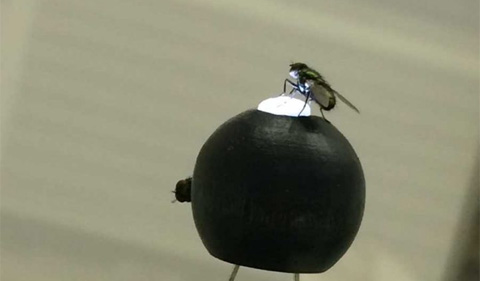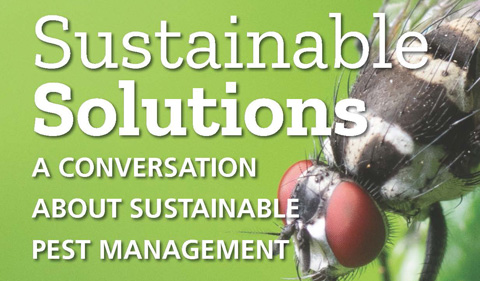The Sustainability Studies theme presents Dr. Bekka Brodie on “Sustainable Solutions: A Conversation about Sustainable Pest Management” on Thursday, Oct. 25, from 4:30 to 6 p.m. in Alden Library 319 (Friends of the Library Room).
Worried about the growing use of chemicals in agriculture and pest management? Come and learn about how research on the elaborate visual system of flies leads to sustainable solutions for fly pest management.
Brodie is a Visiting Professor in Biological Sciences at Ohio University.
Brodie knew she wanted to study entomology after she returned from her two-year service in the Peace Corps in the Fiji Islands. During her master’s (SUNY College of Environmental Science and Forestry) and Ph.D. (Simon Fraser University) programs, Brodie focused on insect chemical ecology. Her research explored how insects use smell to locate mates, and food and egg-laying resources—and how to use this knowledge to manipulate and control insect behavior. However, Brodie’s research revealed that many species of insects use sight rather than smell to communicate.
Brodie is now focusing on how flies use their specialized vision to find resources. By using LED lights flashing at a frequency that mimics light reflected off of a female fly’s wings, Brodie is able to attract male flies. This demonstrates a previously unrecognized visual mate recognition system and the potential for this technology to be applied for sustainable manipulation and control of flies.

Male blow flies responding to LED light flashing at 178 Hz to mimic light reflecting off wings of a female fly. Photo provided by Dr. Bekka Brodie.
At Ohio University, Brodie is working to apply this LED technology (known as flashing wing beat frequency) combined with other visual cues such as ultraviolet, polarized, and infrared light to manipulate midges, a pest fly that infests wastewater treatment plants and parasitic bird blow flies.
Water treatment facilities are equipped with many huge holding takes that collect, filter and process waste. This environment provides an ideal habitat for midges that feed on the decaying aquatic material (human waste). Under these conditions the midge fly populations soar and impact the amount of wastewater being processed and the quality of the treated water. They also are a significant nuisance to employees who breathe the adult flies in or get them in their eyes and mouths. Brodie’s research aims at developing alternative solutions to insecticides by identifying environmentally friendly solutions through the fly’s visual communication pathways.
Parasitic bird blow flies are an invasive species that is harming Darwin’s Finches in the Galapagos Islands. According to Brodie, the larval blow flies attach themselves to the baby birds at night and suck their blood. By morning, they retreat to the bottom of the nests where they hide (safe from becoming a meal by parent birds). Brodie says she is able to study these blow flies because they are present and non-invasive in Ohio, but she hopes that what is learned can be applied to suppress populations of the invasive fly in the Galapagos.
Brodie is looking forward to having conversations about how her work contributes to the development of sustainable solutions to pest management as a way to reduce reliance on harmful chemicals.






















Comments